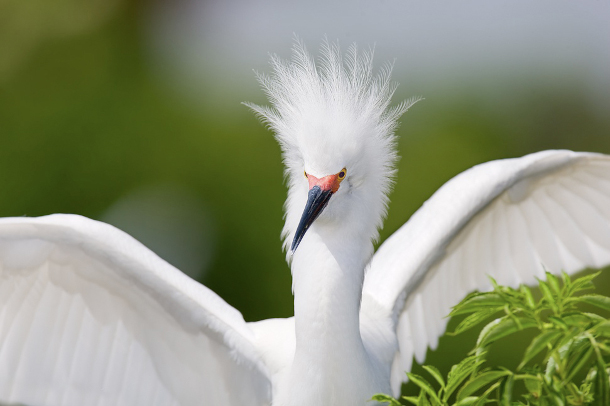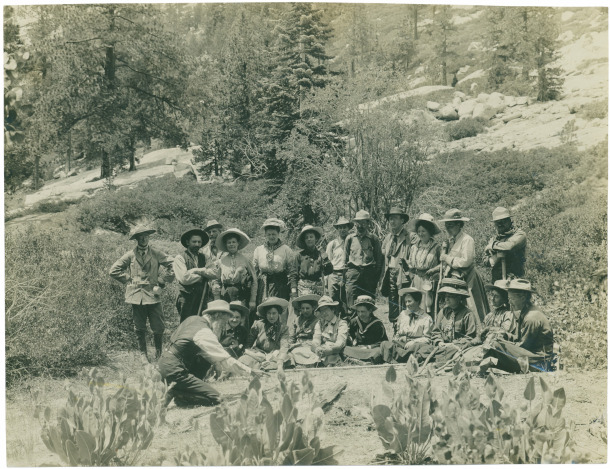From the History Books
Air Date: Week of May 24, 2024

A snowy egret (Egretta hula) displays its plumage. Under threat of extinction in the early 20th century, the snowy egret is now in the “Least concern” category. (Photo: William H. Majoros, Wikimedia Commons, CC-BY-SA 4.0)
This week, Living on Earth Contributor Peter Dykstra and Host Aynsley O’Neill look back to the Lacey Act of 1900, one of the first wildlife protection laws. They also note the founding of the Sierra Club and discuss how the conservation legacy of its first president John Muir has been complicated by his racist views on Native and African Americans.
Transcript
O'NEILL: Joining me now on the line is Peter Dykstra, the Living on Earth contributor who is here to bring us a couple of stories from the history books. Hiya, Peter, what do you have for me this week?
DYKSTRA: Hi Aynsley, a couple of things that go back over a century. The first one, May 25, 1900. That's the day that the U.S. President William McKinley signed the Lacey Act. Lacey was one of the first sweeping wildlife protection laws. It limited the interstate and international trafficking in fish, birds, mammals and plants. Of particular interest is that birds with colorful plumage were being wiped out to help suit the fashion industry of the day, particularly ladies' hats that tended to have a lot of elaborate feathers. And the Lacey Act, along with the establishment of National Wildlife Refuge in places like Louisiana and Florida, helped curb the impact of the wild fashion rage that had gripped the country around the turn of the 19th century to the 20th.

Congressman John F. Lacey from Iowa received the title of “Father of Federal Conservation Legislation” for introducing the Lacey Act in the House of Representatives. (Photo: Benjamin Franklin Gue, Wikimedia Commons, Public Domain)
O'NEILL: Yeah, the Act was designed to protect species like the Snowy Egret, which had this beautiful plumage, and I believe now in the 21st century, it's marked "least concern." So it looks like for the Snowy Egret, it did its job of protection.
DYKSTRA: And unfortunately, it didn't protect presidents from being shot. And little more than a year later, President McKinley was assassinated. His vice president, one of the great conservationists of the day, Teddy Roosevelt, took office in October of 1901.
O'NEILL: Okay, and Peter, what else do you have for me this week?
DYKSTRA: A few years before that, on May 28, 1892, the Sierra Club was founded in San Francisco with 182 charter members. The president elected in that founding meeting was John Muir. He led the effort to preserve the Hetch Hetchy Valley, and the Yosemite area in central California, which has gone on today to be one of our most popular, most visited national parks. Muir was a consummate conservationist for his day. But like many leaders back then, he very freely dissed African Americans and Native Americans, and that puts things in a little different light for what a 19th-century conservationist was and what a 21st-century conservationist ought to be.

A photograph from 1909 depicts naturalist John Muir (front, on the ground), accompanied by a group from the Sierra Club hiking on a trail. (Photo: George R. King, Wikimedia Commons, Public domain)
O'NEILL: Yeah, John Muir's legacy is—it’s definitely complicated by all that racism. Alright, Peter. Well, thank you for that trip back in time. Peter Dykstra is a regular contributor to Living on Earth, and we will talk to you again soon.
DYKSTRA: All right, Aynsley, thanks a lot. Talk to you soon.
O'NEILL: And there's more on these stories on the Living on Earth website. That's L-O-E dot O-R-G.
Links
Living on Earth wants to hear from you!
Living on Earth
62 Calef Highway, Suite 212
Lee, NH 03861
Telephone: 617-287-4121
E-mail: comments@loe.org
Newsletter [Click here]
Donate to Living on Earth!
Living on Earth is an independent media program and relies entirely on contributions from listeners and institutions supporting public service. Please donate now to preserve an independent environmental voice.
NewsletterLiving on Earth offers a weekly delivery of the show's rundown to your mailbox. Sign up for our newsletter today!
 Sailors For The Sea: Be the change you want to sea.
Sailors For The Sea: Be the change you want to sea.
 The Grantham Foundation for the Protection of the Environment: Committed to protecting and improving the health of the global environment.
The Grantham Foundation for the Protection of the Environment: Committed to protecting and improving the health of the global environment.
 Contribute to Living on Earth and receive, as our gift to you, an archival print of one of Mark Seth Lender's extraordinary wildlife photographs. Follow the link to see Mark's current collection of photographs.
Contribute to Living on Earth and receive, as our gift to you, an archival print of one of Mark Seth Lender's extraordinary wildlife photographs. Follow the link to see Mark's current collection of photographs.
 Buy a signed copy of Mark Seth Lender's book Smeagull the Seagull & support Living on Earth
Buy a signed copy of Mark Seth Lender's book Smeagull the Seagull & support Living on Earth

